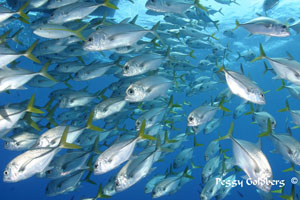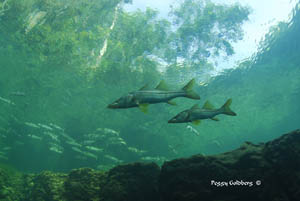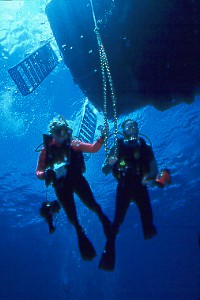|
Where Have All the Fish Gone?
 As early as the end of the last century, the experts felt that the fisheries were inexhaustible – and it would be
useless to try and regulate them. It only goes to show you how wrong we can be.
Seafood consumption has never been at an all time high as it has been now, and Nature magazine published recently that a
scientific assessment of our fisheries shows that if we don’t do something now to correct the problem of overfishing,
commercial seafood will be gone by the year 2050.
Aside from feeding billions more people, the other reason we are losing our food source is we have better more
efficient tools for taking the fish. It also changes the whole ecosystem, which is crucial to our survival.
As early as the end of the last century, the experts felt that the fisheries were inexhaustible – and it would be
useless to try and regulate them. It only goes to show you how wrong we can be.
Seafood consumption has never been at an all time high as it has been now, and Nature magazine published recently that a
scientific assessment of our fisheries shows that if we don’t do something now to correct the problem of overfishing,
commercial seafood will be gone by the year 2050.
Aside from feeding billions more people, the other reason we are losing our food source is we have better more
efficient tools for taking the fish. It also changes the whole ecosystem, which is crucial to our survival.
Many fishing methods are unsustainable. And it is devastating for the ecosystems to function properly. We are
using fishing methods that don’t discriminate what is being caught, causing tremendous destruction to nontarget
species. Bottom trawlers destroy the seabed as they go, scraping an area larger than the size of the U.S. each year,
sucking up everything in its path. Then, they turn around and throw back about 30% as “bycatch”. Most are dead when
they are returned to the sea. That is a lot of wasted tonnage of not only fish, but many other types of creatures.
Each year, the size of the fish gets smaller and smaller, as we have routinely only caught the biggest- which were
the grandfathers and the best breeders, so they never had a chance to pass those genes on.
The result of this all out attack on our oceans tells a disturbing story. Almost 80% of our world’s fisheries are
depleted or on the verge of collapse! 90% of all our large predatory fish are gone from the sea. We really don’t know the true picture of the rest of the fish species- these are only estimates of the species we are targeting, so the status is likely to be worse.
Is it hopeless? If we don’t act now, it just may be…
What can we do? Be a part of the solution.
1. There has been strong evidence that shows where we have set aside large areas as no take zones, and had
restrictions on overfishing, giving species a safe place and some time to recover, that the range of species
increased by almost a quarter after only five years. As divers, we have seen this first hand in countries
that have implemented marine sanctuaries - instead of the people starving, their economies improved with more
tourism, and as fish have no sense of where the boundaries were, would still enable the locals to fish the
non restricted areas. They are also catching bigger fish. However, we must also realize it is as important
to protect the bigger members of the species. Saving the larger female fish produces more healthier eggs.
So having both a minimum and maximum size limit is very important.
2. Protect important habitats like reefs, spawning and nursing grounds (like the mangrove habitats)
3. Reduce the bycatch by fisheries.
4. End all fishing subsidies. Did you know that it costs more to catch the fish than it does to sell the fish?
How is that for a business plan? The fisheries only survive because of government subsidies in the form of grants,
free or low cost fuel, price controls, or no interest loans. You are paying so the fishing industry makes a profit.
Why? Is it because the fishing industry employs over 200 million people and the loss of those jobs would ruin many
regional economies?
5. Enforce the laws and have effective monitoring - if you don’t monitor what is going on, how can you enforce what
is going on? We already have satellite tracking devices for vessels - we need more funds to make them mandatory.
6. Stay abreast of conservation issues and be informed. Make your voice heard. Refrain from eating certain fish-
and explain why to your family and friends. Know what your elected officials are doing about overfishing and destructive
fishing practices.

You have all the power - in that you are the one that makes the choice to buy. Money
controls everything, and without the demand, the problem wouldn’t exist. (Think of shark fin soup and shark finning
practices). There are seafood guides put out by several organizations like the Blue Ocean Institute and Monterey Bay
Aquarium that show the species that are threatened or are harvested by destructive methods. You can use them to avoid
those species the next time you eat out or shop at the market. The guides also list species that are abundant.
If you understand the condition of our oceans, you will be better served to help governments pass legislation to create marine
preserves, ban destructive fishing practices, and label fish on how they are caught. Avoiding eating fish species that have been
over fished is something that can make a major impact on the wallets of those fisheries. We as a species, have a credit card
mentality - buy now and pay later - with no thought to the consequences. Think about the consequences when we take the last fish
from the sea…..
Check out these important websites for more information.
Monterey Bay Aquarium Seafood Watch
http://www.mbayaq.org/cr/seafoodwatch.asp
Blue Ocean Institute
http://www.blueoceaninstitute.org
FishWatch
http://www.nmfs.noaa.gov/fishwatch
http://overfishing.org
Seafood Choices Alliance
http://www.seafoodchoices.com/home.php
Ocean Conservancy
http://www.oceanconservancy.org
Please feel free to respond to any of the
articles, and if you have news you wish to share, please email me at
pgoldberg@goldenimages-photo-scuba.com
.
|



